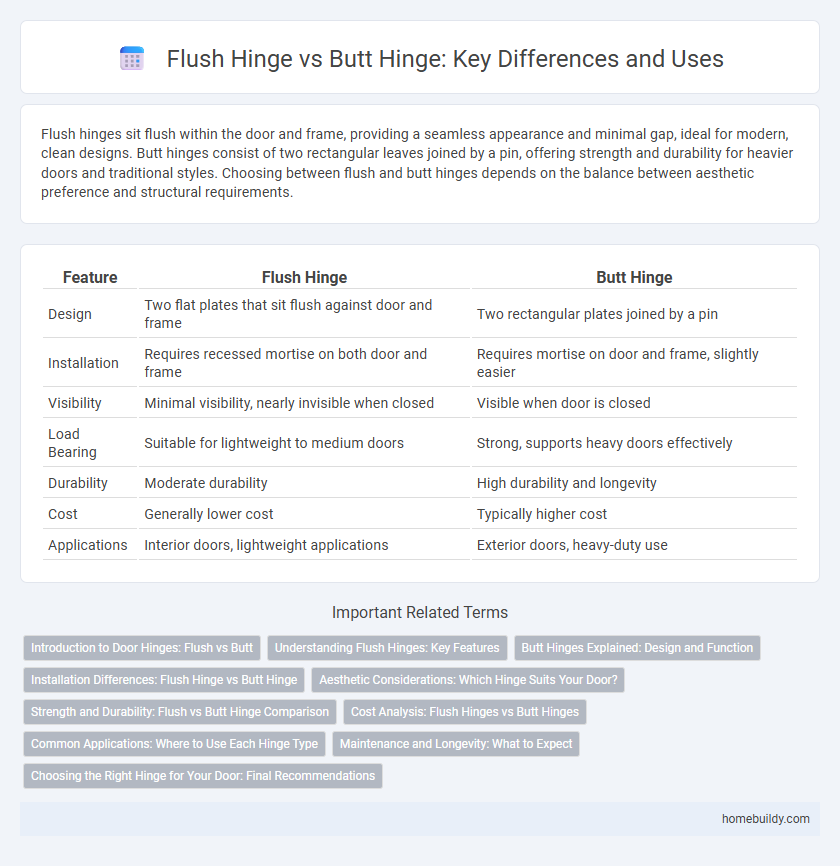Flush hinges sit flush within the door and frame, providing a seamless appearance and minimal gap, ideal for modern, clean designs. Butt hinges consist of two rectangular leaves joined by a pin, offering strength and durability for heavier doors and traditional styles. Choosing between flush and butt hinges depends on the balance between aesthetic preference and structural requirements.
Table of Comparison
| Feature | Flush Hinge | Butt Hinge |
|---|---|---|
| Design | Two flat plates that sit flush against door and frame | Two rectangular plates joined by a pin |
| Installation | Requires recessed mortise on both door and frame | Requires mortise on door and frame, slightly easier |
| Visibility | Minimal visibility, nearly invisible when closed | Visible when door is closed |
| Load Bearing | Suitable for lightweight to medium doors | Strong, supports heavy doors effectively |
| Durability | Moderate durability | High durability and longevity |
| Cost | Generally lower cost | Typically higher cost |
| Applications | Interior doors, lightweight applications | Exterior doors, heavy-duty use |
Introduction to Door Hinges: Flush vs Butt
Flush hinges and butt hinges serve as essential components in door installation, each offering distinct design and functionality benefits. Flush hinges sit entirely within the door and frame, providing a seamless appearance and allowing doors to close flush with the frame, making them ideal for modern, minimalist interiors. Butt hinges consist of two plates, or leaves, that are mortised into the door and frame, providing robust support and durability, commonly found in traditional and heavy doors.
Understanding Flush Hinges: Key Features
Flush hinges are designed to sit completely level within the door and frame, allowing for a seamless, flat appearance without gaps. They are typically smaller and less obtrusive than butt hinges, making them ideal for applications where aesthetics and smooth door operation are prioritized. Their installation requires precise mortising to ensure the door closes flush with the frame, enhancing both functionality and visual appeal.
Butt Hinges Explained: Design and Function
Butt hinges consist of two rectangular metal plates joined by a central pin, designed to fit into mortises on both the door and frame for a flush fit. Their strong, simple design ensures smooth pivoting and reliable support for heavy doors, making them ideal for residential and commercial applications. These hinges provide a clean aesthetic with minimal gap visibility, enhancing both functionality and visual appeal.
Installation Differences: Flush Hinge vs Butt Hinge
Flush hinges install directly into the door and frame, requiring precise mortising for a seamless, flush fit that allows the door to sit evenly within the frame. Butt hinges mount on the door edge and frame surface, involving less intricate cutting but creating a visible overlay when the door is closed. Installation of flush hinges demands higher accuracy and specialized tools, whereas butt hinges offer a simpler setup suitable for most standard doors.
Aesthetic Considerations: Which Hinge Suits Your Door?
Flush hinges provide a sleek, minimalistic look by sitting nearly invisible when the door is closed, ideal for modern and contemporary designs. Butt hinges, with their classic two-plate design and exposed knuckle, offer a traditional aesthetic that complements rustic, vintage, or craftsman-style doors. Choosing between flush and butt hinges depends on whether a seamless appearance or a visible, robust hinge detail better suits the door's overall style and architectural context.
Strength and Durability: Flush vs Butt Hinge Comparison
Butt hinges offer superior strength and durability compared to flush hinges due to their robust construction and deep seating into both the door and frame, making them ideal for heavy doors and high-traffic areas. Flush hinges, while providing a sleek, hidden appearance, typically have lower load-bearing capacity and are more suitable for lightweight doors or cabinets. The metal thickness and pin quality in butt hinges contribute significantly to their long-lasting performance under stress and frequent use.
Cost Analysis: Flush Hinges vs Butt Hinges
Flush hinges generally cost more than butt hinges due to their complex design and the precision required for installation, making them a premium choice for sleek, concealed door applications. Butt hinges, known for their straightforward design and ease of installation, offer a more budget-friendly option suitable for most standard door types without sacrificing durability. When evaluating cost-effectiveness, flush hinges provide an aesthetic advantage at a higher price point, while butt hinges deliver reliable performance with lower upfront costs.
Common Applications: Where to Use Each Hinge Type
Flush hinges are commonly used in cabinetry and lightweight interior doors where a smooth, continuous surface is desired, ensuring the door sits flush with the frame for sleek aesthetics. Butt hinges are ideal for heavier doors, such as exterior entry doors or large interior doors, providing robust support and durability due to their mortised installation into the door and frame. Both hinge types are selected based on door weight, style preference, and installation requirements to maximize functionality and appearance.
Maintenance and Longevity: What to Expect
Flush hinges, designed to sit perfectly aligned with the door and frame, require minimal maintenance due to their concealed mechanism, reducing exposure to dust and debris. Butt hinges, with their traditional exposed knuckles, need regular lubrication and inspection to prevent rust and ensure smooth operation over time. When it comes to longevity, flush hinges typically offer longer durability in indoor settings, while butt hinges can withstand heavier use and are better suited for external doors with proper maintenance.
Choosing the Right Hinge for Your Door: Final Recommendations
Flush hinges provide a sleek, seamless appearance by allowing the door and frame to sit flush, ideal for modern interiors and concealed installations. Butt hinges offer robust support and durability, making them suitable for heavier doors and traditional settings requiring reliable load-bearing capacity. Selecting the right hinge depends on door weight, aesthetic preferences, and installation type, with flush hinges favoring minimalism and butt hinges excelling in strength and long-term performance.
flush hinge vs butt hinge Infographic

 homebuildy.com
homebuildy.com